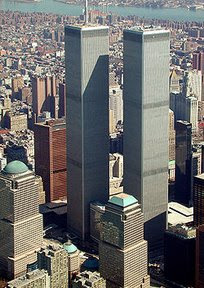Good morning, Whitewater
There are no scheduled public meetings in the City of Whitewater again today. Whitewater, did you get your Christmas wish early? I think you did.
The National Weather Service predicts a certainty of snow, with a high of 26 degrees. The Farmers’ Almanac predicts that today will be fair and pleasant.
Yesterday’s better prediction: NWS.
In world history on this date, in 1970 Wired reports that the “World Trade Center Tops Out”:
Construction workers place the highest steel on the highest building in the world. New Yorkers will first hate it, then get used to it and eventually mourn its destruction.
The massive project was conceived in the 1950s to energize lower Manhattan. Architect Minoru Yamasaki worked in conjunction with Emery Roth and Sons to design twin towers 110 stories high.
Ground was broken Aug. 5, 1966, and steel construction began in August 1968. The North Tower topped out at 1,368 feet (some sources say 1,353 feet) Dec. 23, 1970. Ribbon-cutting took place April 4, 1973.
The twin towers knocked New York City’s own Empire State Building (1931, 1,250 feet) off the top of the list of the world’s tallest buildings, but lost out in 1974 to Chicago’s Sears Tower at 1,451 feet. The twin 1,483-foot Petronas Towers in Kuala Lumpur, Malaysia, surpassed Sears in 1998, only to be overtaken by Taipei 101 in Taiwan at 1,667 feet in 2004. But Burj Dubai in the United Arab Emirates is already above 2,250 feet and slated to reach 2,300 feet soon.
With an acre of rentable space on each of the upper floors of each tower, the WTC’s 110 stories were occupied by about 50,000 people. The South Tower had an observation deck on its 107th floor, offering views for 45 miles in all directions, skies permitting.
The architects and engineers had solved a number of problems with great ingenuity. To keep the nearby Hudson River from flooding its foundations, the buildings were constructed in a vast concrete case, called the Bathtub. A central core in each tower carried the dead (or gravitational) weight of the building’s materials, while light walls were designed to withstand the force of wind on a tall, giant building.
The amount of space taken up by elevators was reduced by creating “sky lobbies” at the 41st and 74th floor, served by express elevators. Local elevators could stop at any floor within each zone. It was a vertical model of a New York subway line.
Despite these innovations, many New Yorkers greeted the towers with derision. They were assailed for being out of scale with the surrounding neighborhoods and a distortion of the classic midtown peak of the Manhattan skyline. Some rudely suggested that the towers looked like the plain boxes out of which two Art Deco classics, the Empire State Building and Chrysler Building, had been unpacked.
Yamasaki died in 1986. The final building in the 16-acre complex, 7 World Trade Center, was completed the following year.Terrorists exploded a massive bomb in the WTC’s parking garage Feb. 26, 1993, killing six people and
injuring more than a thousand. The towers withstood the blast.But they could not withstand the impact of the fully fueled jetliners that terrorists crashed into the twin towers Sept. 11, 2001. That attack brought them down within hours, killing almost 2,800 people.
Construction on new WTC buildings, including the Freedom Tower to replace the twin towers, is now underway.

